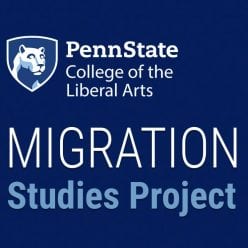Mission
Migration today goes beyond the stereotypical notion of poor people entering a more developed country (presumably in the Northern hemisphere), seeking a better quality of life. Migration is not just from South to the North, it is also importantly South to South. In addition to movement across national borders, we must acknowledge the massive displacement of people within a state. In Asia and Africa, war and famine drive people within their own country to seek refuge. In addition to economic migration, therefore, we must account for forced migration which causes catastrophic life changes for many. We must also see past individual migrants moving to a single location, and consider the ways in which whole communities move in interconnected stages–as in step migration. At times, such movement can involve multiple locations in migratory chains. Sri Lankan refugees often first go to the Middle East for employment, then seek political asylum in European countries, and then move to North America in search of prospects that utilize their knowledge of English first gained during colonial times. Some immigrants now return to their home country after they make enough money or educate their children, displaying a pattern of circular migration. Furthermore, many migrants now shuttle back and forth between their former and present lands of settlement multiple times a year. Such patterns introduce us to transnational migrants. Typifying this trend are diaspora groups which enjoy a “virtual community” across borders.
Such facets of migration may display a causal chain. Sri Lankan Tamils who fled their country as refugees from the civil war have gone on to construct well established diaspora communities which now attract others who consider migration a path to social status by escaping the internal discriminations of caste or gender. In addition to such social causes and contemporary precipitating factors, historical motivations for migration also persist. Colonization by the British has given Tamils proficiency in English and western education as well as a values system that now motivates their movement to Anglophone countries. These realizations have encouraged scholars to adopt the term migratory process (Lewellen, 2002) and consider the movement of people as an interlinked activity. Others adopt the term migration systems theory (Castles, 2000) to study the causes and effects across social domains in a holistic manner.
New patterns of migration have thrown into question many social constructs, policies, and institutions established in the past. Here are some questions we face: How do we define “citizenship” when people inhabit more than one country; how does economy function when constituting the flow of capital across borders and production networks; what does it mean to have democratic rights, when longtime residents, new immigrants, and transnationals demand civic engagement; how do we conceive of “community” when people not geographically bound together forge multiple relationships; what is the nature of communication in a multilingual environment; and what are the objectives of education when a pluralized civic life and work place require diversified competencies, knowledge, and values?
These questions demand a multidisciplinary approach for answers. Though many academic fields address specific questions in their own fields, we need a more integrated approach. Furthermore, certain residual paradigms (such as the nation-state model) still exert considerable influence on migration studies, accounting for what Castles (2000) calls a “paradigmatic closure.” Often, scholarly perspectives and explanations fail to go beyond the limited manifestations of a phenomenon. For example, in studying migrant workers in the US from a sociological perspective, scholars will gain more if they adopt a historical perspective to see the linkages of the sending country to the host country, a social psychological perspective that explores individual motivations and values that shape relocation, and a cultural studies perspective on the challenges of identity and community membership after migration. To thus overcome “compartmentalization” (Castles, 2000) and ensure integrated knowledge construction, scholars in diverse disciplines must collaborate in explaining any particular migratory experience. It is precisely these challenges that Migration Studies Project attempts to meet, developing a center of excellence on much needed integrated scholarship.
Works Cited
Castles, S. (2000). Ethnicity and Globalization. London: Sage.
Lewellen, T. (2002). The Anthropology of Globalization. London: Bergin Garvey.

